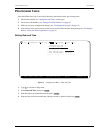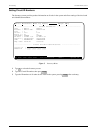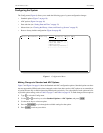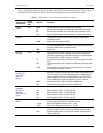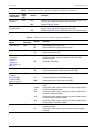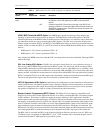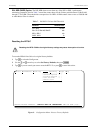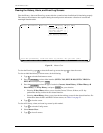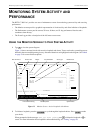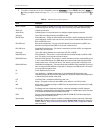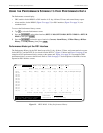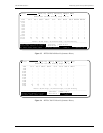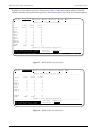
152-388-100-02, Issue 2 Provisioning
H2TU-C-388 List 1 June 6, 2000 19
HDSL2 BER Threshold (HBER) Option. The HBER option permits monitoring of loop integrity and
reporting of alarms when excessive errors are detected. The PM primitive used for this purpose is the CRC
checksum performed on the HDSL2 frame for both directions of transmission. It is, therefore, called a block error
rate rather than the bit error rate associated with the DS1 interface. The CRC errors and counts display on the
Monitor screen for both the H2TU-C and H2TU-R. The HBER option allows an alarm to be generated if the total
number of CRCs at either the H2TU-C or H2TU-R exceeds the selected BER threshold during the last 1-minute
interval.
• HBER option = 1E-6. Alarm is generated if CRC > 92
• HBER option = 1E-7. Alarm is generated if CRC > 9
Once initiated, the HBER count clears when the CRC count drops below the selected threshold. Selecting NONE
inhibits this alarm.
DS1 Line Coding (DS1) Option. The DS1 line code option should always be set to conform to the type of
DS1 service (AMI or B8ZS) being provided by the HiGain system. The Auto mode, which can adapt to either
AMI or B8ZS, should only be used in applications that require it (such as when HiGain acts as a standby circuit
to DS1 circuits whose line codes are not known or may be both AMI and B8ZS). This is because the Auto mode
induces one BPV in the DS1 bit stream whenever it switches from AMI to B8ZS. The Auto mode allows both the
H2TU-C and the H2TU-R to set its DS1 output code to that which is being received at the distant end DS1 input.
This forces the input and the output codes in each direction of transmission to be identical.
H2TU-C Equalization (EQL) Option. Equalization is the configuration of system transmission characteristics
within specified limits. An adaptive equalizer inserts a frequency-shaped loss that corresponds to an equivalent
addition of an appropriate cable length. By simulating the additional cable loss necessary for correct operation,
the equalizer compensates for a range of variation in transmission path characteristics.
Bipolar Violation Transparency (BPVT) Option. The HiGain Line Unit improves compatibility with
Digital Loop Carrier (DLC) feeder applications because of its ability to transmit DS1 BPV occurrences between
its DS1 interfaces. This feature is required to support protection switching in DLC applications. Each DLC
terminal must be able to monitor the integrity of its Receive DS1 payload and then switch to the protect line when
the integrity of the path drops below specific user selected limits. An essential requirement of this feature is the
need for each DLC terminal to detect BPVs in its DS1 input. Standard HDSL systems correct DS1 BPVs at the
input and therefore prevent them from being detected by the DLC terminals to which they are connected. The
HiGain Line Unit and its associated remote units remove this limitation and become BPV transparent by detecting
and counting input BPVs at each end and then by replicating them at the DS1 output port of the distant end.
The BPV count is converted into BPVs at the distant end during the following second at a rate of 1 BPV every
128 DS1 bits up to a maximum of 12000 (BER=7.7 x 10
-3
). This maximum rate is more than adequate since it
exceeds the maximum 10
-3
BER required by most DLC systems.
Remote Disconnect
Alarm
RDA ENA Enables a remote DS1 LOS condition at the input to the H2TU-R to generate
an LOS alarm. AIS or LOS (depending on ALMP) is sent towards the
network.
DIS Prevents a remote DS1 LOS condition at the input to the H2TU-R from
causing an LOS alarm. The front-panel Status LED still flashes red and the
ALRM RLOS message displays. The LOS is sent towards the network from
the H2TU-C instead of AIS.
Table 6. HiGain Line Unit List 1 ADC Config Screen Options (Continued)
ADC Config Screen
Options
Screen
Display Code
Selection Description





